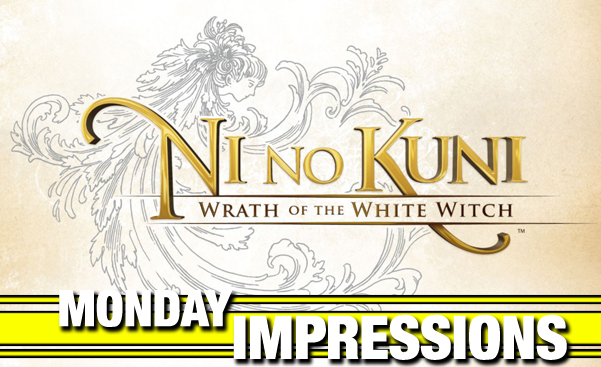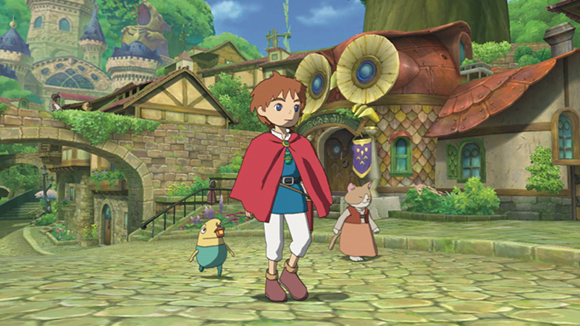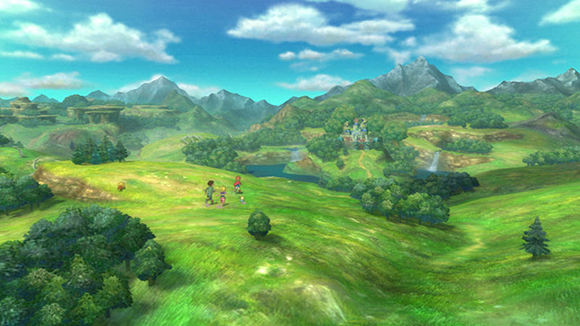Monday Impressions: Ni No Kuni: Wrath of the White Witch
/ It’s such a strange but potentially awesome concept that I had to check it out: Level-5, one of the best JRPG developers out there, teams up with the world-renowned Studio Ghibli to make a game with a hybrid Tales real-time fighting system where you battle with Pokemon-like monsters. How are the results? Ten hours in, and I’m torn. By all rights I should love this game, but somehow I can’t quite bring myself to use that word yet.
It’s such a strange but potentially awesome concept that I had to check it out: Level-5, one of the best JRPG developers out there, teams up with the world-renowned Studio Ghibli to make a game with a hybrid Tales real-time fighting system where you battle with Pokemon-like monsters. How are the results? Ten hours in, and I’m torn. By all rights I should love this game, but somehow I can’t quite bring myself to use that word yet.
Ni No Kuni: Wrath of the White Witch Publishers: Level-5 and Namco-Bandai Developers: Level-5 and Studio Ghibli Platform: PS3 Release Date: January 22, 2013
This supposed JRPG to end all JRPGs begins in a 1950s American suburb. Driven by the titular White Witch, out-of-this-world forces forge a terrible accident in which our young protagonist Oliver loses his mother. But worry not: his tears reanimate the stuffed toy Drippy (the self-proclaimed Lord of the fairies), who convinces Oliver that by helping save his world from the Dark Djinn, he can resurrect his mom. This sets off a journey to the parallel realm and sees the player staring at the beautiful overworld within the first hour of gameplay.
It’s a strong opening, and it sells you on the experience, but it’s also kind of misleading, since it begins with a whole bunch of voice acting and fully animated sequences. The hours that follow have progressively less of these cinematic flourishes, and stick to the fetch-quest paradigm that’s traditionally associated with JRPGs.
I guess if it ain’t broke, don’t fix it, right? Still, the game’s presentation is so polished, one would think that the same level of efficiency would follow in its storytelling, but such is not the case. Of course, your mileage may vary. Many role-playing fans will appreciate that the game takes its time with its story, setting up rather elaborate threads and many likeable characters right off the bat.
Right away you’ll see that Studio Ghibli’s short but voice-acted animated sequences boast the quality of their feature-length cinematic work and rise above even the impressive in-game graphics, which are used for the vast majority of cut-scenes.

Once you reach Ding Dong Dell, the game introduces the “Give Heart” mechanic, wherein Oliver redistributes some emotional wealth by taking virtuous aspects like enthusiasm, kindness and courage from the well-endowed and passing them over to the less fortunate. Ailing the hopeless and despondent makes for a heart-warming gameplay mechanic, but there’s really not much more to it than finding the right people and talking to them. Also, some quests require you to travel back and forth to Motorville, since affecting an individual in one realm will influence their soulmate in the other.
You’ll be able to tell by this point that this is a meaty game, but giving and taking hearts are just the start of it. There are spells to learn, tales of wonder to read, pop quizzes on those tales, familiars to defeat, acquire, metamorphose and buff, and various bounty hunts and side quests to attempt. There’s never a moment where you’ll find yourself at a loss as to what to do, either, as waypoints are clearly marked on the maps.
The familiar system is also very robust, a welcome addition for fans of games such as Pokemon and the Dragon Quest Monsters series. There are a ton of critters to collect and train, and storing, retrieving and upgrading them is never a chore. Here’s a hint for you: don’t metamorphose them as soon as you’re able to. Waiting a few levels will increase their stats when they drop back to level 1 in their next form. Combat is fun and fast-paced, especially once you’ve got your full team assembled.
That’s not to say that the entire experience has been perfect, however. I’ve taken issue with the fact that it takes a lot longer to lay out its full gameplay mechanics and get from place to place than I might have liked, and that for much of the time you’re not going to have the voice acting or fully-animated cut-scenes you were spoiled with near the beginning. Instead, you’ll be grinding, hunting for monsters and doing (mostly short) heartbreak-healing quests. A lot.

When the game brings it, though, it’s more than capable of handing the smack-down, with some seriously challenging boss fights. They’re a great deal more difficult than your average random encounter, and besting many of them will require a lot of preparation and strategy.
This isn’t the sort of epic journey you can hope to complete in a week or two, unless you have unlimited free time and skip every side-quest. It is a long-term commitment, even moreso than the typically lengthy Tales games. The idea is that it eases you into the battle system bit by bit, and Oliver gains power at the same pace that the story progresses. You begin with one familiar, and then two, then three, and then another person joins your human party. Then there’s another trial before you even gain the ability to tame wild enemies into becoming your familiars. I would have preferred that the game had dropped me into the middle of all of these things at once rather than stretching out the experience with hours-long introductory sections, but perhaps it's to make the experience easier for younger players to get into.
Perhaps the game’s slow pace is affecting me moreso than others because I’ve been embarking on every optional side-quest, but I’d really like for the story to kick into high gear. Usually I like to know what the stakes are up front. There’s still a long way to go until Oliver gets to throw down with the White Witch, and I do care for these characters, so I’ll give the game the benefit of the doubt and carry on fighting. I hope my affair with the game will go from puppy love to full-blown adoration.

